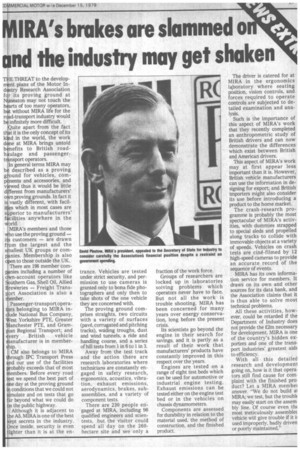IRA's brakes are skimmed o nd the industry may get shaken
Page 29

If you've noticed an error in this article please click here to report it so we can fix it.
E THREAT to the developnt plans of the Motor Ind try Research Association f1 its proving ground at neaton may not touch the h rts of too many operators, b I without MIRA life for the r d-transport industry would infinitely more difficult. uite apart from the fact t t it is the only concept of its d in the world, the work d e at MIRA brings untold b nefits to British roadh ulage and passenger t port operators.
n general terms MIRA may bi described as a proving rund for vehicles, corn • nents and accessories, and 1.wed thus it would be little • i erent from manufacturers' o? proving grounds. In fact it ilvastly different, with facils which in most cases are s perior to manufacturers' f ilities anywhere in the rld.
MIRA's members and those o use the proving ground — customers — are drawn f •m the largest and the s11 allest UK groups or cornflies. Membership is also n to those outside the UK. There are 198 member cornflies including a number of -account operators like uthern Gas, Shell Oil, Allied eweries — Freight Transrt Association is also a ember.
Passenger-transport operars belonging to MIRA inude National Bus Company, est Yorkshire PTE, Greater anchester PTE, and Graman Regional Transport; and ery British vehicle anufacturer is in memberp.
CM also belongs to MIRA rough IPC Transport Press d our use of the facilities obably exceeds that of most embers. Before every road t we spend the best part of e day at the proving ground conditions that we could not mulate and on tests that go r beyond what we could do n the public highway.
Although it is adjacent to e A5, MIRA is one of the best ept secrets in the industry. nce inside, security is even ghter than it is at the en trance. Vehicles are tested under strict security, and permission to use cameras is granted only to bona fide photographers and only then to take shots of the one vehicle they are concerned with.
The proving ground comprises straights, two circuits with a variety of surfaces (pave, corrugated and pitching tracks), wkling troughs, dust and wind tunnels, a ride and handling course, and a series of hill tests from 1 in 6 to 1 in 3.
Away from the test track and the action there are research laboratories where technicians are constantly engaged in safety research, ergonomics, acoustics, vibration, exhaust emissions, aerodynamics, brakes, subassemblies, and a variety of component tests.
There are 230 people engaged at MIRA, including 90 qualified engineers and scientests, but the visitor could spend all day on the 260hectare site and see only a fraction of the work force.
Groups of researchers are locked up in laboratories solving problems which operators never have to face. But not all the work is trouble shooting. MIRA has been concerned for many years over energy conservation, long before the present crisis.
Its scientists go beyond the engine in their search for savings, and it is partly as a result of their work that manufacturers' products have constantly improved in this respect over the years.
Engines are tested on a range of eight test beds which can be used for automotive or industrial engine testing. Exhaust emissions can be tested either on the engine test bed or in the vehicles on chassis dynamometers.
Components are assessed for durability in relation to the material used, the method of construction, and the finished product. The driver is catered for at MIRA in the ergonomics lAboratory where seating position, vision controls, and forces required to operate controls are subjected to detailed examination and analysis.
Such is the importance of this aspect of MIRA's work that they recently completed an anthropometric study of British drivers and can now demonstrate the differences which exist between British and American drivers.
This aspect of MIRA's work may at first appear less important than it is. However, British vehicle manufacturers can use the information in designing for export; and British importers might also consider its use before introducing a product to the home market.
The crash-research programme is probably the most spectacular of MIRA's activities, with dummies strapped to special sleds and propelled along tracks to collide with immovable objects at a variety of speeds. Vehicles on crash tests are eine-filmed by 12 high-speed cameras to provide an accurate record of the sequence of events.
MIRA has its own information service for members. It draws on its own and other sources for its data bank, and the Association claims that it is thus able to solve most technical problems.
All these activities, however, could be retarded if the Department of Industry does not provide the .E2m necessary for development. MIRA is one of the country's hidden exporters and one of the transport industries' greatest aidt to efficiency.
With all this detailed research and development going on, how is it that opera. tors still find cause for complaint with the finished pro, duct? Let a MIRA membei answer. "We do not build al MIRA; we test, but the troublE may easily start on the assem bly line. Of course even th( most meticulously assemble( vehicle will give trouble if it i! used improperly, badly driven or poorly maintained.'




















































































































